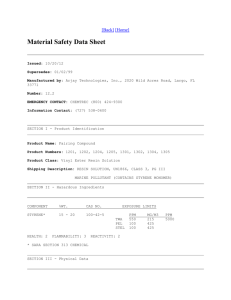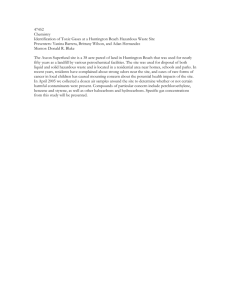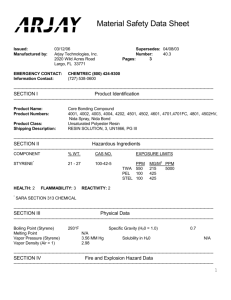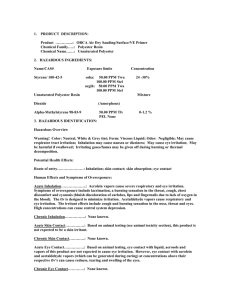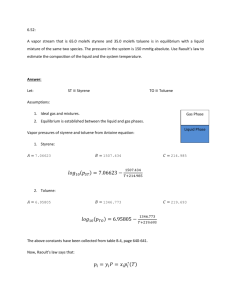3.6 0.890 @ 77.00 DEG F (25.00 DEG C)
advertisement
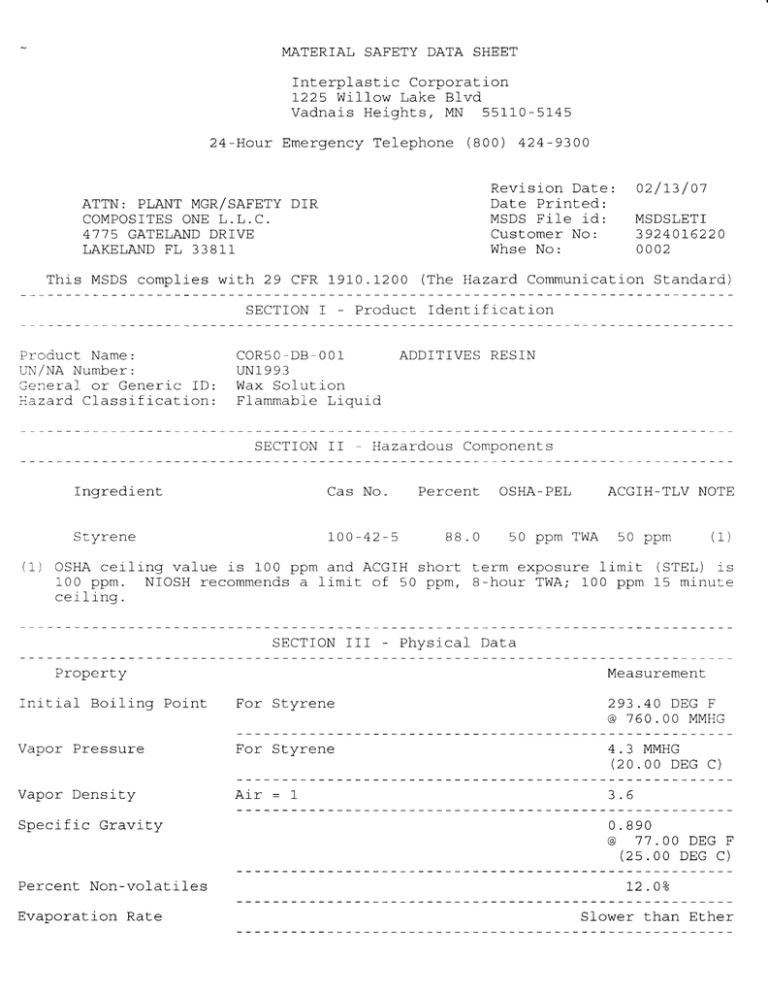
MATERIAL SAFETY DATA SHEET
Tn1- arnl:q1L225
Wf I.LOW
Vadnais
24-Hour
i c
l'-nrnnr:l_
.lJaKe
Heights,
i nn
BIVO.
MN
Emergency Telephone
55110-5145
(800)
Revision
Date :
Date Printed:
MSDS File
id:
Customer No:
Whse No:
ATTN: PLANT MGR/SAFETY DIR
C O M P O S I T E SO N E L . L . C .
4 7 ' 7 5 G A T E L A N DD R I V E
LAKELAND FL 33811
This
MSDS complies
with
z9 CFR 1910.L200
-
SECTION I
Product Name:
LIN/NA Number:
Gereral
or Generi-c ID:
I'iazard Classif ication:
- nn
!vv
nnm
value
N
fr T
r vO
J rS
r H
is
a
a
l i m Lr Lt L ] L
lf
Of
uL
ce j-l-inq.
SECTION TII
Boiling
\/annr
Draqqrrra
\/^n-r
tlanqrr\/
Snoni
f ir.
Percent
-
OSHA-PEL
s0 ppm TWA
88.0
5
J w0
nnm.
IryLLL,
Physical
ACGIH-TLV IVOTE
term
B - hl rov u' rr r
u
exposure
limit
't-larA. 1n^
rvrn,
rvv
Point
(1)
s0 ppm
nnm
}Jtr{LL
(STEL) is
T5
LJ
m
' ou g
L L ri fnr lr u
Data
ts
For
Styrene
293.40 DEG F
@ 760.00 MMHG
F nr
Q l _r z r o n a
4.3 MMHG
(20.00 DEG C)
3.6
(lr:rri
l -r r
Non-volatiles
Erranoral_ i on
Standard)
I\t^
- ^,1*^'a^h
I'lca-urctticllL
Dranorl_rr
Inrtral-
Communication
Components
Percent
100 ppm and ACGTH short
reCOmmendS
!guvrrtLLLurruJ
MSDSLETI
3924016220
0002
Identifrcation
- Hazardous
100-42-5
OSHA cerl-rng
(The Hazard
02/tz / Ol
ADDITIVES RESIN
Cas No.
i anI
Qi-rrrono
1l'
Product
COR50 DB-001
IINI993
Wax Soluti-on
Fl-ammable Liquid
SECTION II
Tnarod
424-9300
Rate
0.890
@ 77.00 DEG F
(25.00 DEG C)
12 .02
Slower
than
Ether
coR50-DB-001
_
Flash
Point
!rra
88 DEG F for
qar n
r u^
Media:
Regular
foam or
Hazardous Decomposition
Products:
and carbon monoxide,
various
carbon
uata
Component
Lower TTnner -
\vyyvrvu_/relre/vyyv!
Extinguishing
roslon
Volatile
(Lowest Value of Styrene)
(ITnner \/alrre of Stvrene)
Ffammable
!H
^ yvr n
r
dioxide
May form toxic
hvdrocarbons.
or
1.1%
6 1Z
dry
materials:
chemical.
,
carbon
dioxide
Special
Flrefighting
Procedures:
Water or foam may cause frothing
which can be
jf
violent
and possibly
endanger the life
of the firefighter,
especi-ally
sprayed into containers
of hoL, burning
liqu)d.
Wear self-contarned
pressure
demand or
Unusual Fj re & Explosion
:lnnn
Fha
arnrrnrl
breathing
apparatus
wiLh a full
face-piece
operated
pressure
other positive
mode when Ilghting
fjres.
Hazards:
Vapors are heavrer
Lhan air and may travef
nr
marr
ho
mnrrad
1 - r r z 1v 7u rgr n
u fl ,i l ]qau tf iv O
rrn
q
a r.r.ul
f iYnr n
r r iL1= _
u
od
ph l .
f
ynLi r' vl L
in
Of
lights,
other
flames,
sparks,
heaters,
smoking, electric
motors,
static
discharge,
or other
ignition
sources at locations
drsLant
from maLerjalpoint.
handling
Never
n-odttr-f
use welding
(errcn
\ u v ! 1 r
or
irrqf
cutting
resi
r - l r r c /)
torch
.u -q rer n
icrni
on or
l _c
near
ercnl
nq
drum
(even
empty)
because
i rrc'l r.z
SECTIONV-HealthData
Permissible
Effects
of
Exposure
Level:
Overexposure:
Not
For
established
for
product.
See Sectron
II.
Styrene
- Can cause severe rrritation,
redness,
tearing,
blurred
vfsl-on.
- Prolonged or repeated contact
can cause moderaLe irritation,
defaLLing,
dermatitrs.
- Excessive
Breathing
inhalation
of vapors can cause nasal- irrrtation,
dizziness,
weakness, fatigue,
nausea, headache, possible
unconsciousness,
and even asphyxiation.
- Can cause gastrointestinal
Swallowing
irritation,
nausea, vomiting,
diarrhea.
aqniration
of materiaf
rnto the lungs can cause chemical pneumonitis.
Eyes
Skin
Frrst
If
If
If
If
A:-d:
on Skin:
Thoroughly
wash exposed area with
soap and water.
Remove
conLaminated
clothing.
Launder contaminated
clothing
before
re-use.
in Eyes:
Fl-ush with large amount of water,
lifting
upper and l-ower lids
occasionally.
Get medical attention.
Swallowed:
do not induce vomiting.
Keep person warm, quiet
and get medical
att.ention.
Aspiration
of material
into
the lungs due to vomiLing
can
cause chemical
pneumonitis
which can be fatal.
Breathed:
If affected,
remove i-ndividual
to fresh air.
If breathing
is
difficult,
administer
oxygen.
If breathing
give artificial
has stopped,
resprration.
Keep person warm, quiet,
and get medical
attentj-on.
coR50-DB-001
-^^^!i--i!--
SECTION V]
Hazardous Polymerization:
Stabfe.
Stability:
Avoid
Incompatibili-ty:
Condrtions
Hazardous
to
uara
Can occur.
strong alkalies,
strong mineral
acids
and oxidizing
agents.
Exposure to excessive
heat or open fl-ame,' storage
in open
to Avoid:
(
e
p
r
o
l
o
n
g
e
d
s
t
o
r
a
g
e
m
o
n
t
h
s
)
s
t
o
r
a
g
e
above
containers
,
;
with oxidizing
38 DEG C (100 DEG F).Contanimation
agents.
Monoxide,
Low Mol-ecufar
Decomposition
Products:Carbon
Carbon Dioxide,
Weight Hydrocarbons.
contact
with:
Spill
SECTION VII
Steps
n^r
Keacr].vrry
be Taken
in
Case Material
or
Leak
Released
is
Procedures
or
Spilled:
Absorb liquid
on paper, vermicufrte,
floor
absorbent,
Spill:
or other
material
absorbent
and transfer
to hood.
(f lares,
Ellminate
f lames, incl-udj-ng prlot
Large Splll:
all
ignition
sources
p
roLecLrve
lrghIs,
electrical
sparks)
Persons noL wearing
equrpment
shoul-d be excluded Irom area o[ sprl]
unt i I clean-up
has been comp I eLed .
Small
Sfon
sni'l
'l
Af
sclnrce
dike
area
of
, g l l ! 9 - " y J l / l l g v l l l Y ,
Remainrng Iiquid
to salvage cank.
ffoor
absorbent
or other
absorbent
llasie
Drsposal
qnill
fer
nrcrren*
qnread
nrrmr.r llrrrrid
ino
may be taken up on sand, c1ay, earth,
materi-al and shoveled
into
containers.
Method:
port j-on to evaporate
Smal-1 Spill :
Allow volatlle
rn hood.
Allow suf f icient
Ljme for vapors to complelely
clear
hood ducc work.
Dispose of remainr-ng
mater:-al
in accordance with applicable
regulations.
-arge
Spi1l:
Destroy by liquid
incj-neraLion
in accordance with applicable
regulat ions .
Contamrnated absorbent
should be disposed of in accordance wrth 1oca1.
state
and federal- requlations.
SECTION VITI
Poqni
r:1_ nrrr
I
D
-- rotectiOn:
l \ T T O q T l / M S H Ai o i
If
Prnf
TT,\/ of
nl'l w
annrorred
I*t|t/-Uuyylrug
er-t i rre
f hc
ai r
Errrr i nment
nrodrrr-f
srrnn'l i cd
or
rpsni
I o
anv
be
Used
comnonenf
rator
is
cwr-ccdod
i s
^
v1luvuvuut
advi_sed
in
u
absence
of proper
environmental
control.
OSHA regulations
al-so permit
other
(\ JSL se e w o r r r -^q ^! cFL y^ F ' .
N TvO
n! iq u vr! -a 1 _c r r s ru rr rnu 9d! e r osl n
'ruS
l l nH A rrsc
u rS
r / I I /r M
Ds
I/a
r ue
u rc
! t ig u f i e d
cvol l unl Ldf i t i _ ov nl f Ds.
u
)/vur
equipment supplier.
Engineering
or administrative
conLrols
should be
)
implemented
to reduce exposure.
Ventilation:
Provide
suf f icient
mechanical- (general
andf or l-ocal- exhaust)
ventilation
to maintain
exposure bel-ow TLV(s) .
Protective
gloves such as:,
Gfoves:
Wear resistant
neoprene,
nitrile
rubber.
rrf
!EJ w
Ue
Prof
e udvt
q
ri
e r : fu ! ivor rn. '
crcrl
!oUu,
.
vCl h
r EeLm
r r ir ru-qar ' l
rharvt yr v^ !l
o r r vo r! !
,
-^u
-^--1
r6^ir-l
YUyyfcb
n tnl -q=Lt f- i U
cp
D
P Ir a D I I
O
v v qf H Ad
!gYUf
^^
ri rnr
a fl
q
r -v oL LmLn} Jl ! ! iqar n
u
r urE- e
w li Lt lhI
qa
narmi
I
ntl'ror
DV
I/gILttrL
(consult
your safety
equipment supplier)
.
Other Protective
Equipment:
Normal- work clothing
VuI19!
covering
\O
J rS) H
n AA
lu__ryrtrsr/ ou
A! rsF
q
rr ce: o
9u
n Jl a
q Li -f vi o
r ln
Dq
q:f
D q ! C L ye
f
.z
n-l
=-d6-
VIdJDU-
arms and legs.
coR50-DB-001
SECTION IX
-
Soecial
Precautions
or
Other
Comments
Containers
of this
materral
may be hazardous when emptied.
Since emptied
(vapors,
product
containers
retain
residues
liquid,
andfor solid) , all
hazard precautions
given in this
data sheet must be observed.
Overexposure
to styrene
has apparently
been found to cause the following
effects
in laboratory
animals:
fiver
abnormalities,
kidney damage, and
lung damage.
The information
accumulated
herein
is believed
to be accurate
but is not
warranted
to be whether originating
wi th Inlerplast:-c
or not.
Recrprents
are advised to confirm
in advance of need that
the information
is
current,
applicable,
and suitabfe
to their
circumstances.
SECTION X -
Sunolement
Styrene has been identified
as a possrble
human carcinogen
by Lhe lnter
natronal
Agency for Research on Cancer (IARC) .
The IARC determinatron
ts
based on "limited
evi-dence" in animals and other
data."
IARC
"refevant
concedes there
is "inadequate
evidence"
on humans for its
findings.
The srgnificance
of these results
for humans has not been established.
Styrene is not expected to cause cancer in humans at concentrations
befow
the recommended exposure
standard
or when appropri-ate
industrral
hlrgt-ene
procedures
are fofl-owed.
Moreover,
in humans exposed for iong
studres
periods
of time to styrene
have not demonstrated
any carcrnogenic
effects.
At
the concl-usion of a malor notice
and comment rulemaking
revising
its
air
contaminants
regulations,
OSHA concluded
that
the "current
evidence on
styrene's
carcinogenicity
does noL support
its
classrfication
in the final
rule as a carcinogen. "
In the same rulemakrng,
the National
Instrtute
for
rrseems to
(NIOSH) commented that
for Occupational
Safety and Health
there
be little
basis from experrmenta-L anrmaf investigalions
or epidemiologic
studies
to conclude at this
time that
is carcinogenic.
styrene
The
"
Nationaf
Toxicology
Program does not include
styrene
lisL
on its
of
chemicafs expected to be carcinoqenic.
SECTION XI
Thi s n
y ,r-o* d
J (r jl Lc t
r F r - r r ' ir r e m c n f q o f
* Suoplier
Notification
i r-f
c jO
C
Q rnrtLadi _
n LSr r S tLoOxXi cI . C C lhl eem
mai C
c aa-l. s s r r l ' ' r c
nf
f hc EmFr.renr-lz
P-ianni
section
313
f n
f he
no
ancl
r- _e Fn _o-r_t _ - -iJn c
Commrrni f v
Right-To-Know
Act of 1986 and of 40 CFR 372.
Pfease refer
to Section
- Hazardous Components for the specific
II
product
and concentration.
